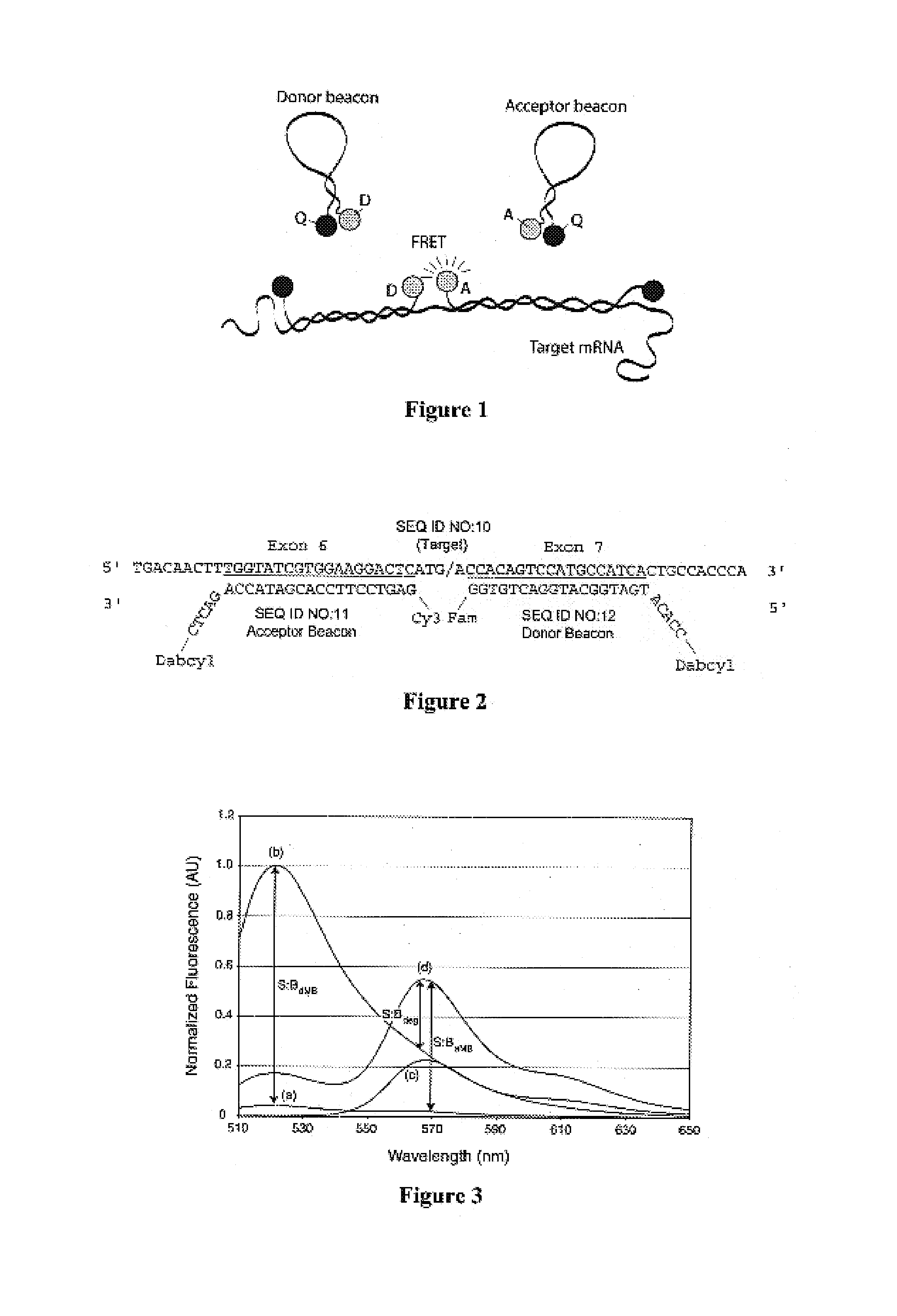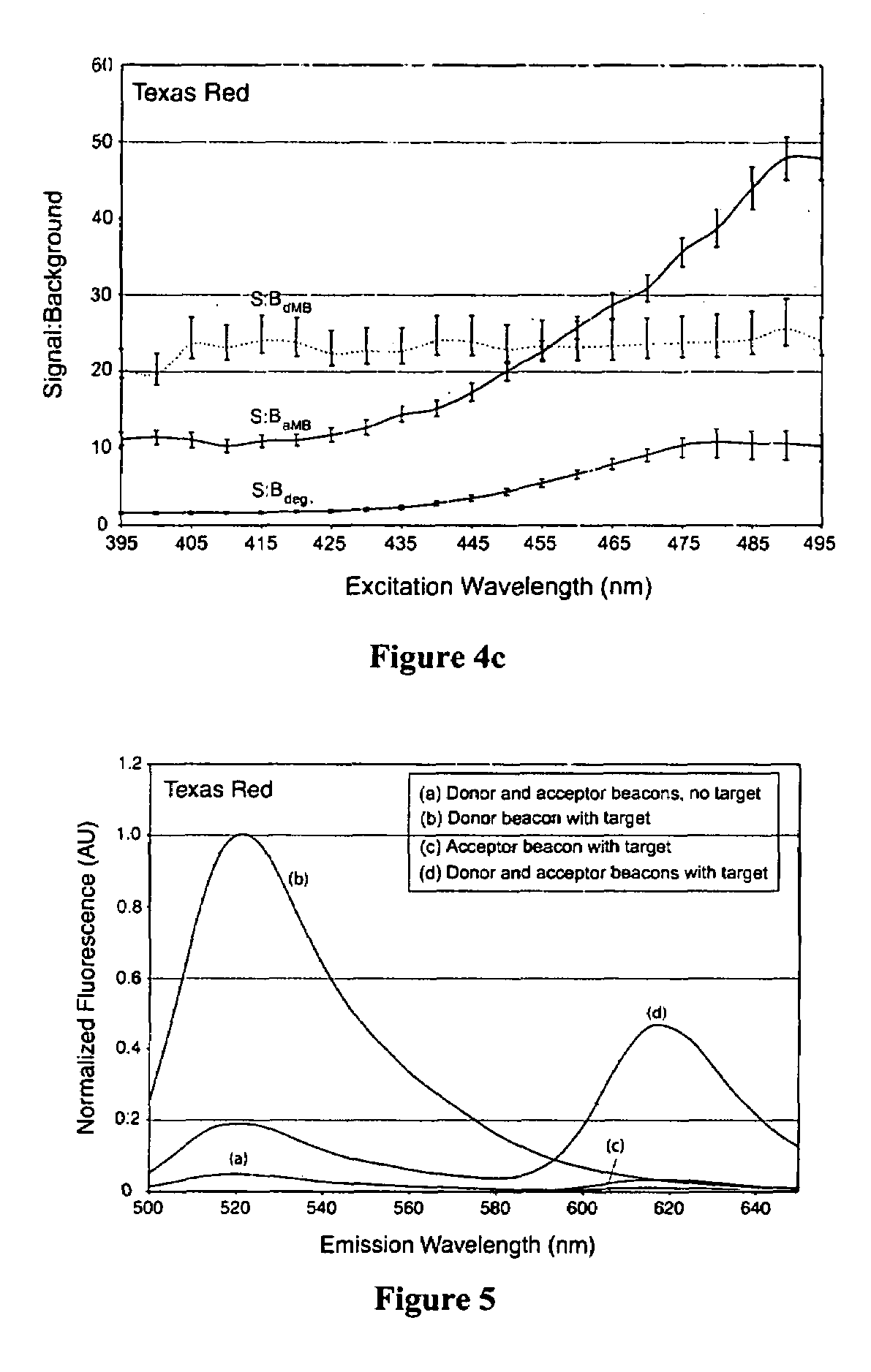Activatable probes and methods for in vivo gene detection
a technology of in vivo gene detection and activation probe, which is applied in the field of target polynucleotide detection, can solve the problems of false positive signals, application of this method to gene detection in living cells, and inability to quantify gene expression in living cells
- Summary
- Abstract
- Description
- Claims
- Application Information
AI Technical Summary
Benefits of technology
Problems solved by technology
Method used
Image
Examples
example 1
Dual Nucleic Acid Probes
[0252]Oligonucleotide Synthesis. Oligonucleotide probes and targets were synthesized using standard phosphoramidite chemistry on an Applied Biosystems model 394 automated DNA synthesizer (Foster City, Calif.). Molecular beacons were purified using dual reverse phase (RP) plus ion-exchange (IE) high performance liquid chromatography (HPLC) on a Waters Model 600E HPLC system (Millipore Corp., Milford, Mass.). For RP-HPLC purification, oligonucleotides were loaded on a Hamilton PRP-1 column and eluted with a linear 5% to 50% acetonitrile gradient in 0.1 M triethyl-ammonium acetate (TEM) pH 7.2 over 40 minutes. The oligonucleotides were additionally purified by IE-HPLC using a Source™ column (Amersham Pharmacia Biotech, Piscataway, N.J.) and eluted with a linear 0% to 50% 1 M LiCl gradient in 0.1 M Tris pH 8.0 over 40 minutes. Unmodified (target) oligonucleotides were purified using polyacrylamide gel electrophoresis. All oligonucleotides were synthesized at Inte...
example 2
Shared Stem Nucleic Acid Probes
[0276]Oligonucleotide Synthesis. Oligonucleotide probes and targets were synthesized using standard phosphoramidite chemistry on an Applied Biosystems model 394 automated DNA synthesizer (Foster City, Calif.). Molecular beacons were purified using a 2-step reverse phase (RP) plus ion-exchange (IE) high performance liquid chromatography (HPLC) on a Waters Model 600E HPLC system (Millipore Corp., Milford, Mass.). For RP-HPLC purification, oligonucleotides were loaded on a Hamilton PRP-1 column and eluted with a linear 5% to 50% acetonitrile gradient in 0.1 M triethyl-ammonium acetate (TEM) pH 7.2 over 40 minutes. The oligonucleotides were additionally purified by IE-HPLC using a Source™ column (Amersham Pharmacia Biotech, Piscataway, N.J.) and eluted with a linear 0% to 50% 1 M LiCl gradient in 0.1 M Tris pH 8.0 over 40 minutes. Unmodified (target) oligonucleotides were purified using polyacrylamide gel electrophoresis. All oligonucleotides were synthesi...
example 3
K-ras and Survivin Detection
[0300]It is well established that cancer cells develop due to genetic alterations in oncogenes and tumor suppressor genes and abnormalities in gene expression that provide growth advantage and metastatic potential to the cells. A critical step in diagnosing and treating cancer in its early stages is to detect cancer cells based on the genetic alterations. An important example is pancreatic cancer, the fifth most fatal cancer in the US. Only 12% of patients diagnosed with pancreatic cancer can survive for one year; the 5-year overall survival rate is approximately 3-5%. The main reason for the poor prognosis of pancreatic cancer is that very few of these cancers can be found early. Current clinical diagnostic procedures such as CT-scan and endoscopic retrograde cholangiopancreatography (ERCP) have a low sensitivity in detecting pancreatic tumors less than 2 cm in size. In spite of the extensive biomedical research efforts during the last few decades, over ...
PUM
| Property | Measurement | Unit |
|---|---|---|
| wavelength | aaaaa | aaaaa |
| wavelength | aaaaa | aaaaa |
| size | aaaaa | aaaaa |
Abstract
Description
Claims
Application Information
 Login to View More
Login to View More - R&D
- Intellectual Property
- Life Sciences
- Materials
- Tech Scout
- Unparalleled Data Quality
- Higher Quality Content
- 60% Fewer Hallucinations
Browse by: Latest US Patents, China's latest patents, Technical Efficacy Thesaurus, Application Domain, Technology Topic, Popular Technical Reports.
© 2025 PatSnap. All rights reserved.Legal|Privacy policy|Modern Slavery Act Transparency Statement|Sitemap|About US| Contact US: help@patsnap.com



